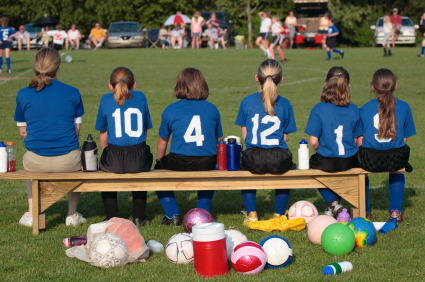As a youth soccer parent knowing the basics of the game will help you enjoy the sport more.
Soccer, as it is known in the United States - it's called football in the rest of the world - has become one of the most popular youth sports in the country. It is played by two teams of eleven players on a rectangular grass or turf field slightly longer and wider than an American football field (note, however, that the size of the field and the number of players is usually modified for kids under the age of 10, or U10). The object of the game is to kick or head a soccer ball into the opposing team's goal. The team with the most goals at the end of regulation play or overtime (if one is played) wins. If the game is still tied after overtime, the game is decided on penalty kicks, with the team with the most goals after each side takes 5 penalty kicks declared the winner.
 Soccer players use their feet to kick the ball to teammates and take shots on goal. They may also use their head and torso to control or pass the ball or direct the ball into the goal. If a ball goes out of bounds on the sidelines, the team that did not touch it last throws the ball into play using an overhead motion. It the ball goes out of bounds on the end lines, either a corner kick, or a goal kick is awarded, depending on which team touched the ball last.
Soccer players use their feet to kick the ball to teammates and take shots on goal. They may also use their head and torso to control or pass the ball or direct the ball into the goal. If a ball goes out of bounds on the sidelines, the team that did not touch it last throws the ball into play using an overhead motion. It the ball goes out of bounds on the end lines, either a corner kick, or a goal kick is awarded, depending on which team touched the ball last.
Fouls occur in soccer fairly often. Fouls include things like, touching the ball with one’s hands or tripping/pushing another player. Fouls can result in direct, indirect, or penalty kicks, and sometimes are accompanied by a yellow or red card being shown to the offending player.
Positions
There are eleven players per side in soccer, a goalie and ten in the field playing a number of different basic positions (forward, midfield and defense) in a variety of different formations.
Forward/Striker
Forwards are sometimes called strikers or attackers. Forwards are positioned closest to the opposing team's goal, hence, they score the majority of goals in soccer. Most teams have two strikers. Usually one forward stays just behind the last defender (i.e. in an on-side position), while the other forward is stationed to assist, as well as score. There are three types of forwards:
- Center Forward: The center forward typically scores the most goals on a team. Center forwards receive the majority of assists from midfield and from cross passes.
- Second Forward: Second forwards, also called supporting or second strikers, are forwards that play almost as both a midfielder and forward, in that they can perform both roles when necessary.
- Wingers: Wings are usually quick forwards or midfielders who position themselves to the outside, closer to the sidelines, and either attack goal from the outside or make centering passes or "crosses" into the penalty area in front of goal for a center forward or striker to either head or kick the ball into the goal.
Players positioned in the middle third of the field between the forwards and defenders.
Defensive/Holding Midfielder
A defensive (or holding) midfielder is a player who is stationed in front of the team's defenders, reducing the ability of the opposing team to attack. A defensive midfielder's role is to strip the ball from the opposing team and pass to ("link up with") attacking midfielders or forwards.
Center Midfielder
Center midfielders play one of the most important positions in soccer. They are often the most versatile and creative players on the team, able to score a goal, defend and make accurate passes.
Attacking Midfielder
Attacking midfielders are positioned farther towards the opponent's goal and assist the forwards in attacking in the offensive third of the field.







